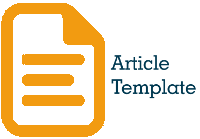ANALYSIS OF FKIP UNSIKA WEBSITE BASED ON HUMAN AND COMPUTER INTERACTION PRINCIPLES
FKIP UNSIKA WEBSITE ANALYSIS BASED ON PRINCIPLES OF HUMAN AND COMPUTER INTERACTION
DOI:
https://doi.org/10.35457/antivirus.v17i1.2870Keywords:
HCI, Heuristic, WebsiteAbstract
The website of the Fakultas Keguruan dan Ilmu Pendidikan Unsika functions as a platform for FKIP Unsika students to access information related to lectures. The purpose of analyzing the FKIP Unsika Website is to understand the relationship between system functions based on the principles and paradigms of Human and Computer Interaction (HCI). In analyzing the Website interface design, the author uses a heuristic evaluation method that evaluates human, technological, usability, and ergonomic aspects. The data used in this research was obtained through distributing questionnaires to respondents who have experience in designing and creating websites, and have a background in informatics. The results show that the rules in the heuristic evaluation method used, such as Visibility of system status, Match between the system and the real world, User control and freedom, Consistency and standards, Recognition rather than recall, and Flexibility and efficiency of use, have not been fully met because there are still problems that need to be fixed.
Downloads
References
[2] Irwanto, A. Yulianti Aulia, A. Solehudin, and A. Voutama, “Perancangan Pembuatan Aplikasi Rental Kendaraan Berbasis Website,” vol. 15, pp. 1–8, 2022.
[3] S. Haryoko, “Penerapan sistem,” pp. 1–8, 2012, [Online]. Available: https://jurnal.akba.ac.id/index.php/inspiration/article/viewFile/20/20
[4] A. Yasinta Permana and A. Voutama, “Cara sitasi: Permana AY, Voutama A. 2022. Pemodelan UML Pada Sistem Penjualan Sembako Di Toko Amshop,” Inf. Manag. Educ. Prof., vol. 7, no. 1, pp. 41–50, 2022.
[5] A. Voutama and E. Novalia, “Perancangan Sistem Informasi Plakat Wisuda Berbasis Web Menggunakan UML dan Model Waterfall,” 2022.
[6] S. Aprudi, “Penerapan Konsep Interaksi Manusia Dan Komputer Pada Sistem Informasi Akademik Fakultas EkonomiUniversitas Musi Rawas,” J. Sigmata, vol. 2, p. 13, 2014.
[7] A. Mubarok Zeidan, Carudin, and Voutama Apriade, “Perancangan User Interface/User Experience Pada Aplikasi Baby Spa Berbasis Mobile Untuk User Customer Dan Terapis Menggunakan Metode User Centered Design,” 2022.
[8] F. Batubara Aulia, “PERANCANGAN WEBSITE PADA PT. RATU ENIM PALEMBANG,” vol. 7, pp. 15–27, 2012.
[9] D. Z. H. Iskandar and A. B. Alpiansah, “Analisa Aplikasi Droidcam Berdasarkan Prinsip dan Paradigma Interaksi Manusia Dan Komputer,” J. Tek. Inform. Kaputama, vol. 5, no. 2, pp. 246–252, 2021.
[10] T. Pujadi, “FAKTOR MANUSIA DAN ERGONOMIS PENGGUNAAN KOMPUTER UNTUK MENINGKATKAN KESEHATAN DAN KESELAMATAN KERJA (K3),” vol. 2, pp. 102–105, 2008.
[11] P. Weichbroth, “Usability of mobile applications: A systematic literature study,” IEEE Access, vol. 8, pp. 55563–55577, 2020, doi: 10.1109/ACCESS.2020.2981892.
[12] N. Dalimunthe, F. Nazari, K. Purba, and A. Adawiyah, “EVALUASI WEBSITE PEMKO PEKANBARU MENGGUNAKAN METODE HEURISTIC EVALUATION,” J. Ilm. Rekayasa dan Manaj. Sist. Inf., vol. 5, no. 2, pp. 245–250, 2019, doi: 10.24014/rmsi.v5i2.8243.
[13] R. Akhsani, A. K. Nalendra, M. Mujiono, and I. Ismanto, “Pengukuran User Experience Pada Aplikasi Pasbhara Dengan Metode Heuristic Evaluation,” Res. J. Comput. Inf. Syst. Technol. Manag., vol. 3, no. 1, p. 38, 2020, doi: 10.25273/research.v3i1.6247.
Downloads
Published
Issue
Section
License
Authors who publish with this journal agree to the following terms:
- Copyright on any article is retained by the author(s).
- Author grant the journal, right of first publication with the work simultaneously licensed under a Creative Commons Attribution License that allows others to share the work with an acknowledgement of the work’s authorship and initial publication in this journal.
- Authors are able to enter into separate, additional contractual arrangements for the non-exclusive distribution of the journal’s published version of the work (e.g., post it to an institutional repository or publish it in a book), with an acknowledgement of its initial publication in this journal.
- Authors are permitted and encouraged to post their work online (e.g., in institutional repositories or on their website) prior to and during the submission process, as it can lead to productive exchanges, as well as earlier and greater citation of published work.
- The article and any associated published material is distributed under the Creative Commons Attribution-ShareAlike 4.0 International License











